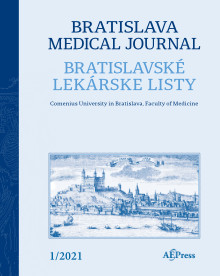Journal info
|
||||
Select Journal
Journals
Bratislava Medical Journal 2024 2023 2022 2021 2020 2019 2018 2017 2016 2015 2014 2013 2012 Ekologia - Ecology Endocrine Regulations General Physiology and Biophysics Neoplasma Acta Virologica Studia Psychologica Cardiology Letters Psychológia a patopsych. dieťaťa Kovove Materialy-Metallic Materials Slovenská hudba 2025Webshop Cart
Your Cart is currently empty.
Info: Your browser does not accept cookies. To put products into your cart and purchase them you need to enable cookies.
Bratislava Medical Journal Vol.124, No.10, p.738–741, 2023 |
||
| Title: Risk of genitourinary malignancy in patients that receive anticoagulant or antiplatelet therapy | ||
| Author: Katerina RYSANKOVA, Adela VRTKOVA, Michal GREPL Viktoria FILIPKOVA, Adriena VESELA, Jan KRHUT | ||
| Abstract: OBJECTIVES: Haematuria is a common indication for a urology evaluation. In many cases, its cause is not determined unequivocally, but it does not pose any threat to the patient. However, it can represent the first symptom of urinary tract cancer. BACKGROUND: The present study aimed to compare the risk of urological malignancies in patients with haematuria who received antiplatelet or anticoagulant therapy versus those who did not. METHODS: This prospective study included 562 patients with haematuria during the period of 2018‒2021. Among these, 129 patients had macroscopic haematuria. All patients underwent a urinary tract ultrasound, CT with urography, and cystoscopy. Patients with suspected malignancy underwent an appropriate surgical procedure with a pathology examination. Data were analysed with univariate and multiple logistic regression. RESULTS: The incidence rates of malignancies were 21.5 % overall, and 44.2 % and 14.8 % among patients with macroscopic and microscopic haematuria, respectively. Univariate regression showed that the odds of malignancy was significantly higher among patients with antiplatelet therapy compared to patients without antiplatelet therapy (OR: 1.88, 95% CI: 1.14‒3.05). In contrast, anticoagulation therapy did not significantly increase the odds of malignancy compared to no anticoagulation therapy (OR: 1.45, 95% CI: 0.74‒2.69). However, a multiple logistic regression model that included other known risk factors (e.g., sex or age) showed similar odds of malignancy among these patient groups. CONCLUSIONS: Malignancy risk for patients who received anticoagulant or antiplatelet therapy was similar to the risk observed in the general population. Antiplatelet and anticoagulant therapy were not significant risk factors of urological malignancy in patients with haematuria. The results from the present study will be used in a power analysis for an upcoming multicentre study (Tab. 4, Ref. 17). Text in PDF www.elis.sk |
||
| Keywords: anticoagulation therapy, antiplatelet therapy, cancer, haematuria, risk factor | ||
| Published online: 07-Aug-2023 | ||
| Year: 2023, Volume: 124, Issue: 10 | Page From: 738, Page To: 741 | |
| doi:10.4149/BLL_2023_112 |
||
|
|
 download file download file |
|

